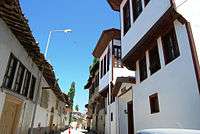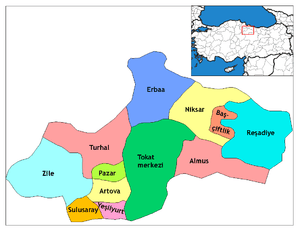Tokat
| Tokat | |
|---|---|
| Municipality | |
|
Yeşilırmak River (Yeşilırmak) and Tokat views. | |
 Tokat | |
| Coordinates: 40°18′50″N 36°33′15″E / 40.31389°N 36.55417°ECoordinates: 40°18′50″N 36°33′15″E / 40.31389°N 36.55417°E | |
| Country | Turkey |
| Province | Tokat |
| Government | |
| • Mayor | Eyüp Eroğlu |
| • Governor | Cevdet Can |
| Area[1] | |
| • District | 1,923.01 km2 (742.48 sq mi) |
| Population (2012)[2] | |
| • Urban | 132,437 |
| • District | 182,225 |
| • District density | 95/km2 (250/sq mi) |
| postal code | 60100, 60200 |
| Area code(s) | +90 356 |
| Website |
www |
Tokat is the capital city of Tokat Province of Turkey in the mid-Black Sea region of Anatolia. It is located at the confluence of the Tokat River (Tokat Suyu) with the Yeşilırmak. In the 2009 census, the city of Tokat had a population of 129,879.
History
The city was established in the Hittite era. During the time of King Mithradates VI of Pontus, it was one of his many strongholds in Asia Minor.
Known as Evdokia (Evdoksia, Dokia), it was later incorporated into the western part of the Byzantine Greek Empire of Trebizond.
After the Battle of Manzikert (1054) the town, like most of Asia Minor, came under the control of the Seljuk Turks. After the death of Sultan Suleiman ibn Qutulmish in 1086, the Emir Danishmend Gazi took control of the area, operating from his power base in the town of Sivas. It would be many decades before the Seljuks re-took control of that region, in the reign of Kilij Arslan II.
After the Battle of Köse Dağ, Seljuk hold over the region was lost, and local Emirs such as the Eretna took power until the rise of the Ottomans.
Ecclesiastical History
Even under Seljuk Muslim rule, Tokat remained a centre of Pontic Greek culture and the Greek Orthodox church.
In 1859 was established as a residential diocese of the Armenian Catholic Eparchy of Tokat on territory previously without a proper Ordinary of its Eastern Catholic particular church sui iurus (Armenian Rite in the Armenian language).
The only recorded residential incumbent Eparch (Bishop) of Tokat was Arsenio Avak-Wartan Angiarakian (15 August 1859 – 4 July 1865), emeritate as Titular Archbishop of Tarsus (21 July 1865 – death 8 April 1874).
On 30 May 1892 the diocese was suppressed and its territory reassigned to the Armenian Catholic Eparchy of Sebaste.
In 1972 the diocese was nominally restored as Titular bishopric of Tokat, but is vacant after a single incumbent, of the lowest (episcopal) rank, Titular Bishop Vartan Achkarian, Mechitarists (C.A.M., Benedictine) (28 September 1987 – death 28 July 2012), Auxiliary Eparch of the patriarchal province Cilicia of the Armenians (Lebanon) (28 September 1987 – 1997), Bishop of Curia of the Armenians (1997 – 2002), Auxiliary Eparch of Beirut of the Armenians (Lebanon) (2002 – 11 June 2011).
Climate
Tokat has a hot-summer Mediterranean climate (Köppen climate classification:Csa) with considerable maritime and continental influences.
| Climate data for Tokat (1950-2015) | |||||||||||||
|---|---|---|---|---|---|---|---|---|---|---|---|---|---|
| Month | Jan | Feb | Mar | Apr | May | Jun | Jul | Aug | Sep | Oct | Nov | Dec | Year |
| Record high °C (°F) | 20.2 (68.4) |
22.8 (73) |
31.1 (88) |
35.1 (95.2) |
36.4 (97.5) |
39.8 (103.6) |
45.0 (113) |
40.8 (105.4) |
38.9 (102) |
35.3 (95.5) |
35.6 (96.1) |
23.0 (73.4) |
45 (113) |
| Average high °C (°F) | 6.0 (42.8) |
8.1 (46.6) |
13.1 (55.6) |
18.9 (66) |
23.4 (74.1) |
26.7 (80.1) |
29.0 (84.2) |
29.5 (85.1) |
26.3 (79.3) |
20.7 (69.3) |
13.6 (56.5) |
8.0 (46.4) |
18.61 (65.5) |
| Daily mean °C (°F) | 1.8 (35.2) |
3.4 (38.1) |
7.4 (45.3) |
12.5 (54.5) |
16.5 (61.7) |
19.9 (67.8) |
22.3 (72.1) |
22.3 (72.1) |
18.7 (65.7) |
13.7 (56.7) |
7.9 (46.2) |
3.8 (38.8) |
12.52 (54.52) |
| Average low °C (°F) | −1.8 (28.8) |
−0.8 (30.6) |
2.4 (36.3) |
6.6 (43.9) |
10.0 (50) |
13.0 (55.4) |
15.5 (59.9) |
15.5 (59.9) |
12.1 (53.8) |
8.2 (46.8) |
3.4 (38.1) |
0.4 (32.7) |
7.04 (44.68) |
| Average precipitation mm (inches) | 40.3 (1.587) |
34.2 (1.346) |
40.0 (1.575) |
56.1 (2.209) |
59.3 (2.335) |
38.0 (1.496) |
11.5 (0.453) |
5.7 (0.224) |
17.8 (0.701) |
39.5 (1.555) |
44.9 (1.768) |
47.8 (1.882) |
435.1 (17.131) |
| Average rainy days | 11.3 | 10.9 | 12.1 | 12.9 | 13.7 | 8.7 | 3.0 | 2.3 | 4.9 | 8.0 | 9.5 | 12.0 | 109.3 |
| Mean monthly sunshine hours | 86.8 | 106.4 | 155 | 183 | 229.4 | 258 | 272.8 | 288.3 | 252 | 186 | 123 | 77.5 | 2,218.2 |
| Source: Devlet Meteoroloji İşleri Genel Müdürlüğü [3] | |||||||||||||
Economy

Historically, copper was mined in the area.
Culture
Education
Gaziosmanpaşa University is one of Turkey's newer tertiary institutions, founded in 1992. It was named after the local hero Gazi Osman Paşa.
Sports
Football is the most popular sport: in the older districts above the city center children often kick balls around in the evenings in the smallest streets. The city's football club is Tokatspor, which plays its games at the Tokat Gaziosmanpaşa Stadium.
Basketball, volleyball, tennis, swimming, cable skiing (in summer), horse riding, go karting, paintballing, martial arts and many other sports are played. Cycling and jogging are only common along the sea front, where recreational fishing is also popular.
Cuisine
Foods distinctive to Tokat include Tokat kebabı and Zile pekmezi, the latter being served in a wooden pot. Tokat kebabı consists of sliced lamb, aubergines, potatoes, green bell peppers and tomatoes. The slices are laid on their sides in rows in a dish and baked with cloves of garlic.[4] Zile pekmezi is a grape-molasses confection, prepared from a variety of small green grapes, which are pressed (traditionally by foot but nowadays by machine) and then evaporated to a thick syrup by boiling. Egg-whites are then beaten into the syrup until it forms a pale marshmallow-like paste. It is sold commercially in tubs.[5]
Tourism

The most important landmark is Tokat Castle, an Ottoman citadel with 28 towers on a rocky hill overlooking the town. Vlad the Impaler (Count Dracula) was imprisoned in one of its dungeons.[6][7] Other sights include the remains of several Greek Orthodox churches and a cathedral, the Garipler Mosque dating to the 12th century, the Ali Paşa Mosque (16th century), and the Gök Medrese (Pervane Bey Darussifasi), which was constructed in 1270. It was founded as a school of theology, and is now converted into a museum, housing archaeological finds from the area.
The Latifoglu Konak, a late 18th-century Ottoman residence, is an example of Baroque architecture. The two-story building has been restored and has been converted into a small museum. Much of the furniture in the kitchen, study, visitors' rooms with bath and toilet, bedroom, master's room, and harem is original.
Ballıca Cave is a small cave situated at 6 km (3.8 mi) southeast of Pazar, Tokat Province.
Notable people
- Gazi Osman Paşa (1832-1897), Ottoman commander
- Mehmet Emin Tokadi Hazretleri (1664-1745), Sufi saint of Istanbul
- Krikor Balakian (1875-1934), Armenian bishop
- Cahit Külebi (1917–1997), Turkish poet
- Engin Günaydın (1972-), Turkish actor and comedian
- Hüseyin Akbaş (1933-1989), Turkish World and Olympic Champion in wrestling
- Seda Sayan (1964-), Turkish pop folk singer, actress and TV variety-show hostess
- Aziz Kocaoğlu (1948-), mayor and politician.
International relations
Tokat is twinned with:
|
Europe
|
Africa |
See also
References
- ↑ "Area of regions (including lakes), km²". Regional Statistics Database. Turkish Statistical Institute. 2002. Retrieved 2013-03-05.
- ↑ "Population of province/district centers and towns/villages by districts - 2012". Address Based Population Registration System (ABPRS) Database. Turkish Statistical Institute. Retrieved 2013-02-27.
- ↑ Resmi İstatistikler (İllerimize Ait İstatistiki Veriler) DMİ.gov.tr (4 September 2014)
- ↑ Tokat Kebabı on YouTube
- ↑ "Zile pekmezi", Zile haber (Commerce of Zile), Tokat, Turkey (Turkish)
- ↑ 'Dracula's Dungeon' Discovered by Archaeologists at Tokat Castle in Turkey
- ↑ Archaeologists In Turkey Say They've Discovered Dracula's Dungeon
- ↑ Tokat’ın kardeş şehir ve belediyeleri, Tokat Newspaper, (16 June 2013)
- ↑ İllere Göre Kardeş Şehirler, Presidency of Religious Affairs (2013)
Sources and External links
| Wikimedia Commons has media related to Tokat. |
- Tokat at kultur.gov.tr
- Tokat web news
